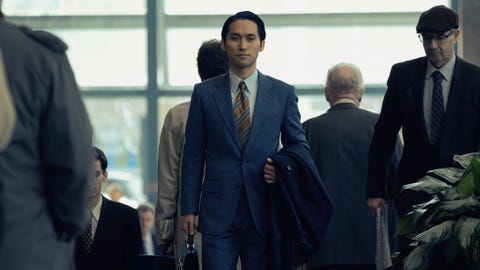Warning: This article contains spoilers for the AppleTV+ show Pachinko.
When Min Jin Lee published her second novel, Pachinko, in 2017, it became a finalist for the National Book Award, and received rave reviews. Still, television and film agent Theresa Kane-Lowe thought a television adaptation of the sprawling historical novel was “an impossibility,” according to a TIME interview.
Spanning four generations of a Korean family through the 20th century, the novel presents the largely untold tale of Korean immigrants in Japan. Much like the epic and often-confusing Dune, showrunner Soo Hugh (Under the Dome, The Terror) had a huge undertaking to adapt a story with a large cast, multiple languages (Korean, English, and Japanese), and various historical periods ultimately interweaving with one another.
The price tag for such a daunting task rivaled that of The Crown (which boasts a whopping $13 million per episode), according to The Hollywood Reporter. After a particularly tense bidding war, AppleTV+ snatched up the television adaptation, and from the trailer alone, it’s clear that the streamer spared no expense to stay as close to the original novel’s enormous scope as possible.
Still, no book to television (or movie) translation can perfectly transition. There are only so many characters, plot lines, and locations that a viewer can keep track of. The book and show primarily follow Sunja, who we first meet in her fishing village with her parents, and see all the way into the 1980’s. Hugh wrote the show to last four seasons, and already the first season has changed how the story is told. There’s no telling which characters will be emphasized more than others over the course of the series, or if entire details of Sunja’s life will be omitted.
From the premiere of the first three episodes, we can say what’s missing from the get go, whether you’re a fan of the book eagerly awaiting the adaptation, or a casual viewer just excited for the show. Here are three major changes in Pachinko. And, of course, don’t read on if you don’t want the show spoiled for you.
The Chronology
In the novel, the tale of Sunja and her family is told in chronological order, starting from Sunja’s birth, and ending in the 1980’s with her grandson, Solomon. The AppleTV+ adaptation, however, plans to juxtapose Sunja’s beginnings with Solomon’s struggles. It’s a bold move, but one that quickly introduces multiple characters, and emphasizes just how Sunja’s choices as a young adult impact the rest of her life. That said, we’ll have to wait and see how the show tries not to spoil too much about Sunja and her family.
Noa
A major character (at least according to IMDb) seems to be missing from the show. Sunja actually has two sons in the novel, Mozasu and Noa. We meet Mozasu and his son Solomon in the premiere, but there’s no cast listing or mention of Noa as of yet. In the novel, Noa’s father is Hansu, the wealthy married man Sunja meets as a young woman and ultimately has a child with. Mozasu is the son of Isak, the man Sunja marries to conceal the identity her firstborn’s father, and to avoid societal shame of having a child out of wedlock.
Mozasu and Noa are raised together, both believing they’re Isak’s children. Only later in the novel does Noa discover who his actual father is, causing him to disown his family. He lives in Japan and does bookkeeping for a racist Japanese pachinko owner, marries, and has children under the false pretense he’s Japanese, not Korean. Eventually, after living under a false identity for years, Sunja finds him again. Distraught he can’t escape his past, Noa commits suicide.
Since Hugh plans to stretch out the show for four seasons, it’s possible Noa could have a storyline next season. But considering we have yet to see any mention of him in the show, it’s possible his story has been combined with Mozasu, and we’ll have to see how the show depicts him discovering his true parentage.
Hana
Mosazu grows up, and partners with a Japanese divorcee, Etsuko. Hana is Etsuko’s daughter from her previous marriage, and is also a troubled teen. As she grows up and gets to know Solomon, Hana enters a brief sexual relationship with him, and then runs away to Tokyo. Eventually, Solomon locates her and sees her one last time, while she’s dying in a hospital bed.
In the television series, it looks like Hana may have a more prevalent storyline in the show, since she’s already been mentioned in the premiere episode. Her emphasized importance, though, leads us to one more major character missing from the show.
Phoebe
While in college, Solomon (in the book he goes to Columbia, but in the show he goes to Yale) meets Phoebe, a Korean-American. After college, the two move back to Japan, where he then meets Hana for the last time.
In the first episode of the series, we quickly see Solomon go from New York to Tokyo with no mention of a significant other. Although Phoebe is a minor character in the book, her absence means the show will most likely put more focus on Hana without exploring Solomon’s other potential romantic interests. Then again, there’s still time to bring in Phoebe in future seasons, so we can’t say she’s completely out of the show just yet.
This content is created and maintained by a third party, and imported onto this page to help users provide their email addresses. You may be able to find more information about this and similar content at piano.io





Comments are closed.